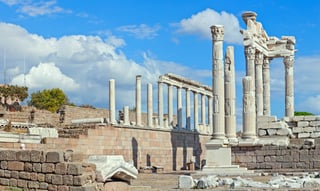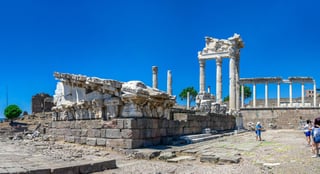Exploring The Ancient City Of Pergamon
The ancient city of Pergamon, also known as Pergamum, is a testament to the grandeur of classical civilizations. Nestled in the modern-day region of western Anatolia in Turkey, it offers a rich tapestry of history, culture, and architecture. This guide delves into the essence of Pergamon, unraveling its historical significance, architectural marvels, and the legacy it leaves behind.

Historical Context
Pergamon's story begins in the 3rd century BCE, founded under the Hellenistic period. It emerged as a prominent city under the rule of the Attalid dynasty, who transformed it into a cultural and intellectual hub. The city reached its zenith under Roman rule, becoming a major center of learning and arts.
Cultural Significance
The city was a beacon of culture and knowledge, housing one of the ancient world's most significant libraries. This library rivaled that of Alexandria, attracting scholars and philosophers. Pergamon also became synonymous with the invention of parchment, revolutionizing the way knowledge was recorded and preserved.
Architectural Marvels of Pergamon
Pergamon's architecture is a mirror to its historical significance, boasting structures that are both aesthetically magnificent and culturally profound.
The Pergamon Acropolis
The Acropolis of Pergamon, an ancient citadel, is the city's crown jewel. Perched atop a commanding hill, it offers panoramic views of the Bakırçay Plain. The Acropolis is home to several significant structures:
- The Great Altar of Pergamon: Now largely housed in the Pergamon Museum, Berlin, this monumental structure is famed for its intricate friezes depicting the battle between the gods and giants.
- The Great Theater: One of the steepest ancient theaters in the world, it accommodated thousands, showcasing advanced Greek engineering.
- The Temple of Trajan: A testament to Roman architectural influence, dedicated to Emperor Trajan.
- The Library: Though its physical remnants are limited, the site symbolizes Pergamon's intellectual legacy.
The Asclepion
A short distance from the main city, the Asclepion was an ancient healing center. It was dedicated to Asclepius, the god of healing, and served as a sanctuary offering various treatments. The complex includes a theater, sacred pools, and treatment rooms, highlighting ancient medical practices.
Other Notable Structures
- The Red Basilica: Originally a temple, later converted into a basilica, showcasing religious transformation over the centuries.
- The Sanctuary of Athena: Devoted to the goddess Athena, illustrating Greek religious practices.
Pergamon's Influence on Art and Culture
Pergamon's art and culture were defined by Hellenistic influences, with a particular emphasis on sculptures and friezes. The city's artistic expressions were characterized by dramatic expressions and intricate details, as evident in the Altar of Pergamon. Its influence extended beyond architecture to literature, philosophy, and science.
The Decline and Rediscovery of Pergamon
The decline of Pergamon began in the Byzantine era, exacerbated by invasions and natural disasters. The city gradually faded into obscurity until its rediscovery in the 19th century, leading to significant archaeological excavations.
Modern-Day Pergamon
Today, Pergamon stands as a UNESCO World Heritage Site, attracting visitors worldwide. The ongoing archaeological efforts continue to unravel new aspects of this ancient city, enriching our understanding of its historical context.
Visiting Pergamon: A Practical Guide

Best Time to Visit
The ideal time to visit Pergamon is during spring or autumn when the weather is mild, and the tourist crowd is manageable.
How to Reach
Pergamon is accessible via Izmir, the nearest major city. Regular bus services and car rentals are available for the journey to Bergama, the town nearest to the site.
Accommodation Options
- Bergama: Offers a range of hotels and guesthouses, providing convenient access to the archaeological site.
- Coastal Towns: Ayvalik and Dikili provide beachside accommodations, combining historical tours with leisure.
- Izmir: Suitable for those seeking a metropolitan experience, with easy access to Pergamon.
Exploring the Site
A guided tour is recommended to fully appreciate Pergamon's historical context. Allocate at least a full day to explore the Acropolis, the Asclepion, and other significant structures. Comfortable walking shoes are a must, given the uneven terrain.
Nearby Attractions
- The Pergamon Museum, Berlin: Home to the Pergamon Altar and other artifacts from the ancient city.
- The Bergama Museum: A local museum in Bergama, housing artifacts found in and around Pergamon.
Conclusion
Pergamon is more than an archaeological site; it is a journey through time, offering insights into ancient civilizations' complexities. Its enduring legacy in architecture, culture, and intellectual pursuits continues to inspire and educate. A visit to Pergamon is not just a tour of ancient ruins but an immersive experience into the heart of human history and achievement.
